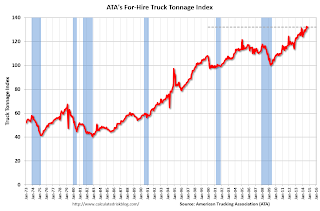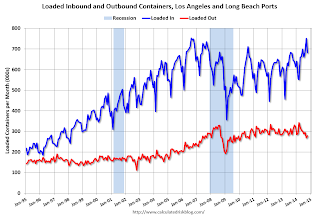by Calculated Risk on 11/18/2014 02:21:00 PM
Tuesday, November 18, 2014
ATA Trucking Index increased 0.5% in October
Here is an indicator that I follow on trucking, from the ATA: ATA Truck Tonnage Index Increased 0.5% in October
American Trucking Associations’ advanced seasonally adjusted For-Hire Truck Tonnage Index rose 0.5% in October, following a revised decline of 0.8% during the previous month. In October, the index equaled 132.1 (2000=100), which was the second highest level on record after August.
Compared with October 2013, the SA index increased 4.5%, up from September’s 2.9% year-over-year gain. Year-to-date, compared with the same period last year, tonnage is up 3.2%. ...
“Tonnage made a nice comeback after declining in September,” said ATA Chief Economist Bob Costello. “The gain fits with the increases in retail sales and factory output during October, as well as with good anecdotal reports about the fall freight season.”
“The solid month-to-month gain, coupled with the acceleration in the year-over-year growth rate, is a good sign for the fourth quarter,” Costello said. “In addition, I’m expecting a solid fall freight season as holiday sales are forecasted to see the largest increase since 2011.”
Trucking serves as a barometer of the U.S. economy, representing 69.1% of tonnage carried by all modes of domestic freight transportation, including manufactured and retail goods. Trucks hauled 9.7 billion tons of freight in 2013. Motor carriers collected $681.7 billion, or 81.2% of total revenue earned by all transport modes.
emphasis added
 Click on graph for larger image.
Click on graph for larger image.Here is a long term graph that shows ATA's For-Hire Truck Tonnage index.
The dashed line is the current level of the index.
The index is now up 4.5% year-over-year.
LA area Port Traffic in October: Strong Imports, Soft Exports
by Calculated Risk on 11/18/2014 12:34:00 PM
Note: There is a trucker strike in LA that might impact port traffic in November. From the LA Times: L.A.-area port truckers expand strike to three new companies
A port truck driver strike at the twin ports of Los Angeles and Long Beach grew Monday, as protest organizers targeted three more companies that they accuse of wage theft. ... The expanded strike comes as tension at the nation’s busiest port complex is high. A powerful dockworkers union and multinational shipping lines are negotiating a new contract for about 20,000 workers on the West Coast.Container traffic gives us an idea about the volume of goods being exported and imported - and possibly some hints about the trade report for October since LA area ports handle about 40% of the nation's container port traffic.
Dockworkers have been without a contract since July ...
The following graphs are for inbound and outbound traffic at the ports of Los Angeles and Long Beach in TEUs (TEUs: 20-foot equivalent units or 20-foot-long cargo container).
To remove the strong seasonal component for inbound traffic, the first graph shows the rolling 12 month average.
 Click on graph for larger image.
Click on graph for larger image.On a rolling 12 month basis, inbound traffic was up 0.5% compared to the rolling 12 months ending in September. Outbound traffic was down 0.9% compared to 12 months ending in September.
Inbound traffic has been increasing, and outbound traffic has been mostly moving sideways.
The 2nd graph is the monthly data (with a strong seasonal pattern for imports).
 Usually imports peak in the July to October period as retailers import goods for the Christmas holiday, and then decline sharply and bottom in February or March (depending on the timing of the Chinese New Year).
Usually imports peak in the July to October period as retailers import goods for the Christmas holiday, and then decline sharply and bottom in February or March (depending on the timing of the Chinese New Year). This was the 3rd highest level for imports in October, only behind October 2006 and 2007.
Imports were up 5.7% year-over-year in October, exports were down 10.4% year-over-year.
This might suggest U.S. retailers are expecting a happy holiday season - but exports suggest a slowdown in Asia.
NAHB: Builder Confidence increased to 58 in November
by Calculated Risk on 11/18/2014 10:00:00 AM
The National Association of Home Builders (NAHB) reported the housing market index (HMI) was at 58 in November, up from 54 in October. Any number above 50 indicates that more builders view sales conditions as good than poor.
From the NAHB: Builder Confidence Rises Four Points in November
Builder confidence in the market for newly built single-family homes rose four points to a level of 58 on the National Association of Home Builders/Wells Fargo Housing Market Index (HMI), released today.
“Growing confidence among consumers is what’s fueling this optimism among builders,” said NAHB Chairman Kevin Kelly, a home builder and developer from Wilmington, Del. “Members in many areas of the country continue to see increasing buyer traffic and signed contracts.”
“Low interest rates, affordable home prices and solid job creation are contributing to a steady housing recovery,” said NAHB Chief Economist David Crowe. “After a slow start to the year, the HMI has remained above the 50-point benchmark for five consecutive months, and we expect the momentum to continue into 2015.”
...
All three HMI components increased in November. The index gauging current sales conditions rose five points to 62, while the index measuring expectations for future sales moved up two points to 66 and the index gauging traffic of prospective buyers increased four points to 45.
Looking at the three-month moving averages for regional HMI scores, the Northeast rose three points to 44, the South posted a four-point gain to 62, and the West edged up one point to 58. The Midwest registered a two-point loss to 57.
emphasis added
 Click on graph for larger image.
Click on graph for larger image.This graph show the NAHB index since Jan 1985.
This was above the consensus forecast of 55.
Monday, November 17, 2014
Tuesday: Homebuilder survey, PPI
by Calculated Risk on 11/17/2014 07:10:00 PM
Some excellent research from the NY Fed Liberty Street Economics: Measuring Labor Market Slack: Are the Long-Term Unemployed Different?. The conclusion:
[W]e find that long-term unemployed workers are not less attached to the labor market than short-term unemployed workers. If anything, the long-term unemployed group has the largest share of prime-age workers, the age group likely to have the strongest labor force attachment. We also see that long-term unemployment is an economy-wide phenomenon, spread across industries and occupations. While there may be unobservable characteristics of long-term unemployed workers that make them less attached to the labor force, when looking at their observable characteristics, it’s hard to argue that they should not be considered as part of labor market slack.The "underutilization of labor resources" may be "gradually diminishing" (from the recent FOMC statement), but based on this research, the unemployment rate, and the number of people working part time for economic reasons, it appears there is still a fair amount of slack in the labor market.
Tuesday:
• At 8:30 AM ET, the Producer Price Index for October from the BLS. The consensus is for a 0.1% decrease in prices, and a 0.1% increase in core PPI.
• At 10:00 AM, the November NAHB homebuilder survey. The consensus is for a reading of 55, up from 54 in October. Any number above 50 indicates that more builders view sales conditions as good than poor.
CoStar: Commercial Real Estate prices increased in September
by Calculated Risk on 11/17/2014 04:14:00 PM
Here is a price index for commercial real estate that I follow.
From CoStar: Commercial Real Estate Price Surge Continues In Third Quarter
NATIONAL COMPOSITE INDICES CONTINUE TO CLIMB. Both the value-weighted and the equal-weighted U.S. Composite Indices of the CCRSI made strong gains in September 2014 to close the quarter. The value-weighted index, which is heavily influenced by core transactions, advanced by 1.9% in the month of September and 3.3% in the third quarter of 2014. The value-weighted index is now 2.8% above its prerecession high and continues to make solid gains. The equal-weighted U.S. Composite Index, which is heavily influenced by smaller non-core deals, increased by 1.3% in September and 4.2% in the third quarter of 2014.
...
ANNUAL PRICE GAINS REALIZED ACROSS ALL MAJOR PROPERTY SECTORS. The retail, industrial, and office segments all moved up toward 2007 pricing levels in September 2014 and are now within 11.4%, 14.4%, and 21.2% of their previous peaks, respectively. The multifamily sector, which recovered earlier than the other property types, is now 1% above its previous peak.
emphasis added
 Click on graph for larger image.
Click on graph for larger image.This graph from CoStar shows the the value-weighted U.S. Composite Index and the equal-weighted U.S. Composite Index indexes.
The value weighted index is above the pre-recession peak, but the equal weighted is still well below the pre-recession peak.
There are indexes by sector and region too.
 The second graph shows indexes by sector.
The second graph shows indexes by sector.The multifamily sector is now above the previous peak. The office sector is lagging.
Note: These are repeat sales indexes - like Case-Shiller for residential - but this is based on far fewer pairs.


